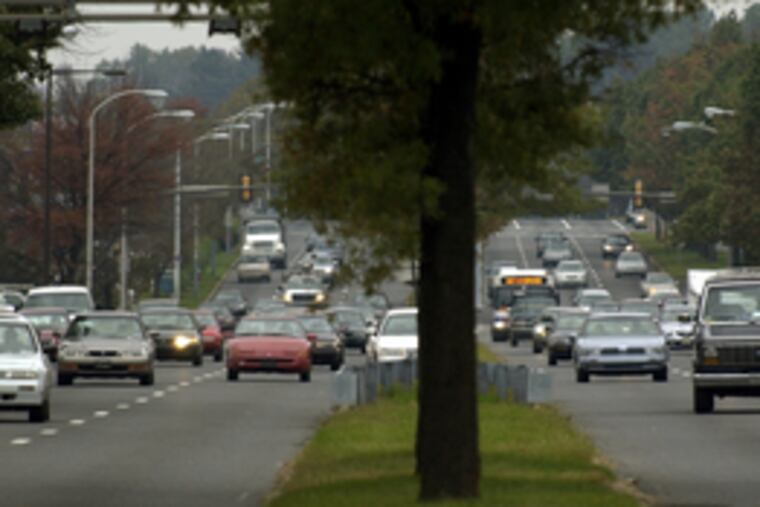Philly lays out options for Roosevelt Blvd.’s future and envisions a road remade
Philadelphia is considering some transformative changes for the famously dangerous road.

In 20 years, Roosevelt Boulevard may be partially capped, turning portions of it into an expressway.
Or it might get light rail service and see its commercial districts transformed into glittering, densely developed transit hubs.
Or it might get the best bus service in Philadelphia, with dedicated lanes for public transit, bike lanes, and space for parking and deliveries.
These are the visions being considered for Philadelphia’s 12-lane thruway to Bucks County. Details are vague, and each plan is likely to cost billions, said Angela Dixon, director of planning for the city’s transportation office. There are likely to be many interim steps along the way, too, from incrementally better bus service to landscaping improvements.
The proposals, though, represent a commitment to remake a road that’s one of the city’s most dangerous and in the process transform the communities around it. “We’ve been looking at this for three years,” Dixon said.
Dixon has been sharing the possibilities at community meetings this month, and one Wednesday night drew about two dozen people.
“It’s more ambitious than any other city plan,” said Ben She, a Philadelphia transit advocate. “It seems like it’s overdue.”
Roosevelt Boulevard has a well-deserved reputation as a treacherous road. In 2018, the road had its deadliest year in half a decade with 21 deaths, more than twice as many as in 2017. So far this year, the Boulevard has seen four deaths in three crashes, according to the Philadelphia Police Department.
>>READ MORE: Traffic deaths on Roosevelt Blvd. spiked in 2018. A safety fix may not be in place until fall.
All options include eventually reducing the number of lanes, which would deter speed, planners said.
The first plan would reduce the lane count to four in each direction, with a dedicated bus lane in each direction. The center four lanes would be depressed for much of the road’s length and fully capped in five places, similar to what was done over the Vine Street Expressway. Depressing the center lanes would allow higher speeds on them while the outer lanes would be for slow-moving local traffic.
The options that would expand bus service or add light rail would reduce the lane count for private vehicles to three in each direction. That layout would be essentially the same for both, with either a bus lane or train track occupying the right side of the center travel lanes. Speed limits would be reduced, and parking added to protect new bike lanes. Both also would add signals at 29 places, mostly at T intersections.
The light rail stops would likely be at the same locations where the current Roosevelt Boulevard Direct bus stops, Dixon said, and that creates opportunities for transit-oriented development to radiate out from them. Dixon noted that redevelopment would be focused largely on existing commercial districts, not residential areas.
Roosevelt Boulevard is a state road, so even if the political will existed in city government, Philadelphia would have to coordinate with PennDot and SEPTA to make these ideas a reality.
“Each agency is going to take the lead and kind of move all together,” Dixon said.
Grand ideas, though, run up against prosaic realities, and at least one person at the meeting said she was concerned about the road losing lanes, even as she complained about how fast people travel on the Boulevard.
“How do you change the mind-set of the lunatic drivers behind the wheel on the road itself?” said Mary Digirolamo, who lives near Roosevelt Boulevard. “That’s why I’m worried about losing lanes, because the volume is really unbearable now.”
About 90,000 vehicles travel the road every day.
The direct bus, which debuted in 2017, also is scheduled to be expanded southwest from the Frankford Transportation Center to the Wissahickon Transportation Center on Ridge Avenue. The city has $2.1 million in grant money to add new stops on the Boulevard between Broad Street and Pratt Street for an extended direct bus. The added service can’t begin, though, until SEPTA rebuilds the bus station at Wissahickon, which is not equipped to manage additional bus traffic.
>>READ MORE: From 80 stops to 8: Express SEPTA bus to debut on Roosevelt Blvd.
SEPTA has a $4 million federal grant to use toward the $14.22 million project to increase the bus station’s capacity, the transit agency reported. The project would likely be finished by 2022.
Next month, the installation of speed cameras is scheduled to begin. They won’t be turned on until close to the end of the year, but the recently legalized technology is supposed to be a first step to slowing traffic before more transformative landscaping and engineering changes can take place.
“We are doing this in an incremental way," Dixon said. "We want to layer things on top of each other.”
More details on the city’s three alternatives, along with the full range of changes planned for the route, are available on rooseveltblvd.com/boards_jun2019/.